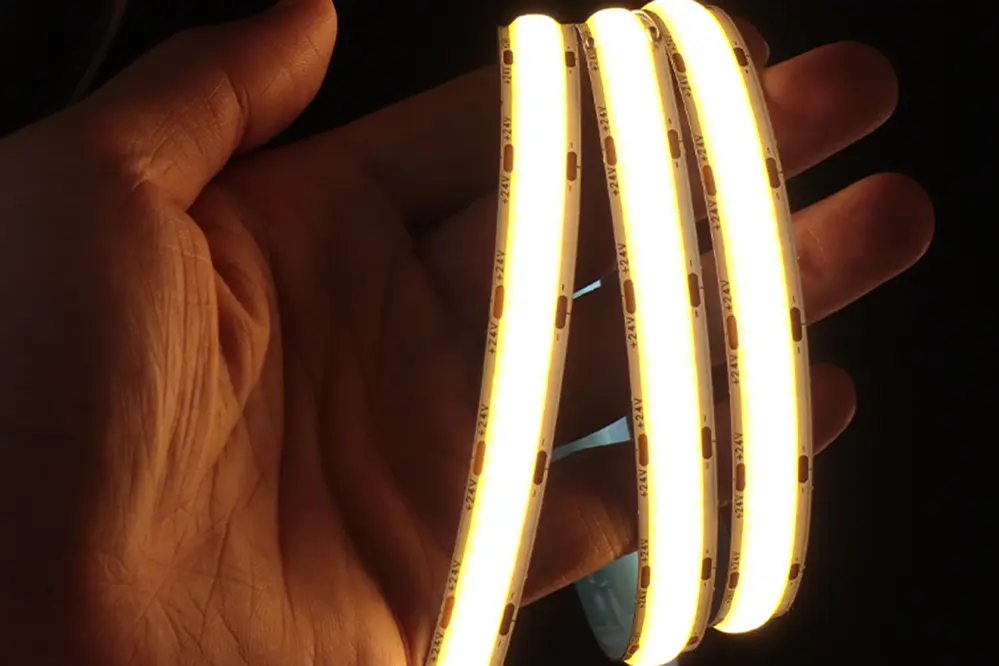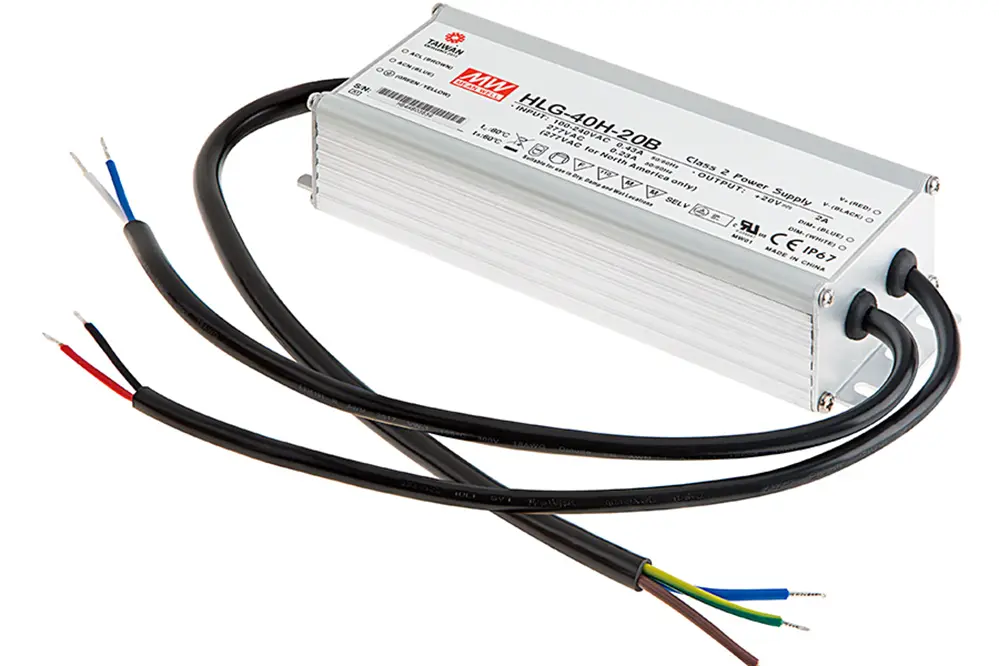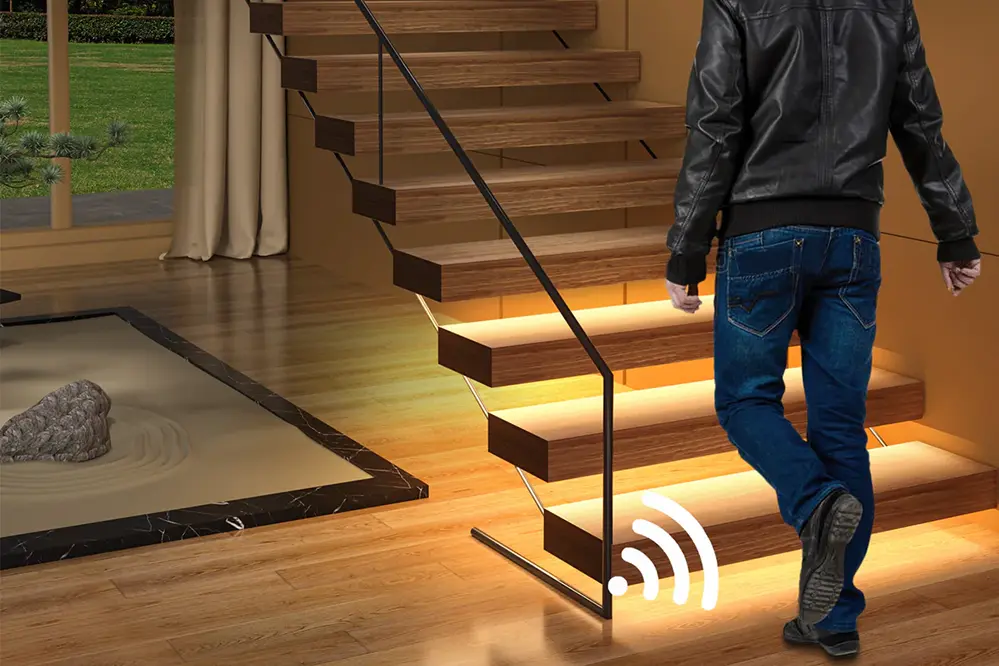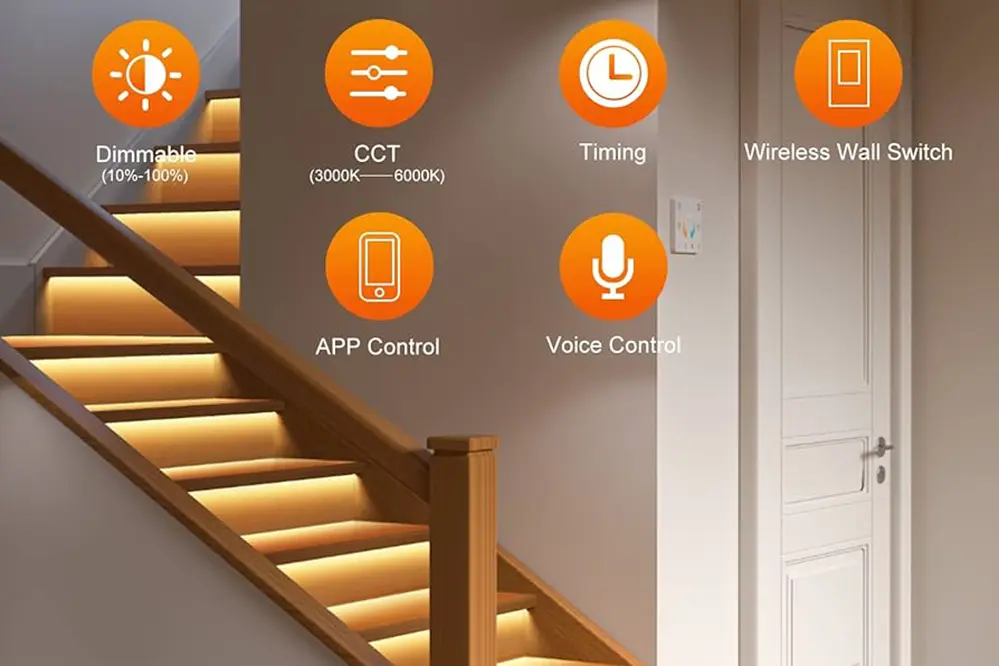How often have you stumbled on a dark staircase, wishing for better lighting? Learning how to install stairway lighting with LED strip lights can solve this common problem, making your home safer and more visually appealing.
Proper stairway lighting is crucial for preventing accidents and enhancing the overall ambiance of your home. According to the National Safety Council, falls are a leading cause of non-fatal injuries, and good lighting can significantly reduce this risk.
There are various solutions available, from traditional lighting fixtures to modern LED strip lights. LED strip lights, in particular, offer energy efficiency, longevity, and a sleek design that can transform any staircase.
In this article, you’ll discover the step-by-step process of installing LED strip lights, from planning the layout to making final adjustments. Get ready to illuminate your stairway and elevate your home’s atmosphere with this practical and stylish upgrade.
Tools and Materials Needed
First and foremost, one will need high-quality LED strip lights, specifically designed for durable and efficient performance.
Additionally, a reliable power supply is critical to ensure the LED lights function optimally. They should also gather connectors and extension cables to seamlessly link the strips and extend their reach, alongside a wireless controller if remote control is desired. Furthermore, cable clips or brackets will help in securely mounting the strips and maintaining a tidy installation.
To ensure precise cuts and connections, a pair of scissors and a soldering kit are indispensable. Proper measuring tools like a tape measure and a pencil will aid in marking exact positions for each LED strip segment, guaranteeing a uniform installation throughout the stairway.
Moreover, safety gear such as gloves and protective eyewear should not be overlooked. Prioritizing safety is paramount, thus it’s wise to consider potential hazards and adhere to necessary precautions. This careful consideration will ensure that the installation project proceeds smoothly and efficiently, resulting in a safe and beautifully lit stairway.
Choosing the Right LED Strip Lights

When installing stair lighting, selecting the right LED strip lights is crucial for both functionality and aesthetics.
Initially, it’s important to consider the brightness level and color temperature, since these factors significantly impact the ambience and visibility of the stairway. High-lumen LED strips provide ample light for safety and navigation, while various color temperatures can complement the overall interior design.
Additionally, opting for LED strips with a suitable waterproof rating may be necessary to ensure dependable connectivity in various environmental conditions. In situations where outdoor or damp conditions are present, investing in waterproof LED strips will enhance durability and ensure long-term performance.
Moreover, one should evaluate the flexibility and cuttable features of the LED strip lights. Flexible strips can easily adapt to the curves and edges of a stairway, while cuttable options allow for precise fitting, ensuring seamless and efficient coverage. This careful selection process will lead to a successful, practical, and visually appealing installation.
Measuring Your Stairway
Before diving into installation, measuring the stairway accurately is paramount to your project’s success.
To begin, take comprehensive measurements of the entire staircase, including steps and landings. This initial step is vital as it ensures the LED strip lights are perfectly placed, providing consistent illumination throughout. One should measure both the horizontal and vertical dimensions, noting any irregularities or unique design features.
Specifically, measure the width of each step and the total length of the stairway. By documenting these measurements, individuals can purchase the correct length of LED strip lights and plan for precise installation, thereby optimizing both aesthetics and functionality.
Finally, consider the positioning of the power source and any potential obstacles, such as banisters or railings. Accurate measurements and a well-thought-out plan will guarantee the LED strips are seamlessly integrated, highlighting the stairway elegantly while enhancing safety. Proactivity in measuring lays the groundwork for an installation that is both impeccable and enduring.
Preparing the LED Strip Lights
Before embarking on the installation, it is essential to prepare the LED strip lights meticulously.
First, ensure the LED strip lights are of the appropriate length and quality. Verify that they are compatible with stairway lighting.
Next, gather all necessary tools and equipment, such as a measuring tape, scissors, and adhesive. This readiness will streamline the process.
Carefully unroll the LED strip lights and inspect them for any defects or damages. A thorough check prevents future disruptions.
Verify that the power supply matches the requirements of the LED strip lights. Proper voltage and compatibility are crucial.
Identifying Power Supply Needs

Determining the correct power supply is paramount to ensure the LED strip lights function safely and efficiently. This step involves calculating the total wattage required.
First, check the power consumption per meter of the LED strip lights. This information is usually provided by the manufacturer.
Second, measure the total length of the LED strips needed for the stairway. Multiply this length by the power consumption per meter.
Next, account for a buffer to ensure the power supply can handle additional demand. Ideally, add a 20% margin to the total wattage calculated.
Then, research and select a power supply that meets or exceeds this wattage requirement. It is wise to prioritize quality and reliability in choosing the power supply.
Finally, test the compatibility of the power supply with the LED strip lights before installation. Confirm all connections and ensure the power supply operates seamlessly to guarantee lasting performance.
Installing the Power Supply
Upon sourcing the correct power supply, it’s time to proceed with the installation process efficiently.
First, locate an accessible and secure area near the stairway to install the power supply. Safety should be a priority.
Then, ensure the power supply is positioned to minimize exposure to dust and moisture. To this end, choose a well-ventilated spot.
Carefully follow the manufacturer’s instructions to mount the power supply securely in place. Double-check all connections.
Finally, verify the power supply’s output aligns with the LED strip lights’ requirements. A seamless setup promises longevity.
Attaching the LED Strip Lights
After determining the optimal placement, a crucial step in enhancing stairway aesthetics, they can begin. Positioning the LED strip lights precisely ensures an even and striking illumination effect. By peeling back the adhesive cover and pressing the strip firmly into place, they can achieve a seamless attachment.
Cleaning the Surface
Properly preparing the surface—cleaning thoroughly—plays a foundational role in the successful installation of stairway lighting with LED strip lights.
A clean surface will ensure the adhesive on the LED strips sticks properly and lasts longer.
Cleaning any dust and debris using a microfiber cloth, followed by a mild detergent solution, is essential. This ensures a residue-free surface, enhancing the durability of the installation.
Allow the surface to dry completely after cleaning—ensuring no moisture remains—before proceeding to install the LED strips for optimal adherence.
Applying the Strip Lights
Position the LED strip lights carefully.
This initial placement will set the stage for the entire project. They must ensure the strip is aligned accurately along the stairway contours, paying attention to each step’s edge. Consequently, adhering to the intended design specifics will provide consistent and safe illumination, enhancing both aesthetics and functionality.
Proper alignment maximizes visual impact.
They should start from the top of the staircase and work down, as this approach offers better control. This method allows for adjustments and realignments as necessary, ensuring precise application throughout the process.
They should now gently press each section of the strip light into place, making sure the adhesive fully adheres to the cleaned surface. This meticulous approach will contribute significantly to the durability and reliability of the stairway lighting installation.
By methodically applying pressure and patience, they can achieve an installation that not only looks elegant but also stands the test of time. Even illumination ensures safety and an ambiance that welcomes and impresses.
Connecting the LED Lights to Power
With the LED strips securely in place, connecting the lights to power becomes the next critical step.
For this, they should gather necessary tools such as a screwdriver, wire strippers, connectors, and a power supply. After confirming that the power source is capable of handling the load, they should connect the LED strips to the power supply, ensuring the connections are tight and secure to prevent any loose ends that could disrupt the lighting.
Carefully, they should then test the connection by briefly turning on the power supply. If everything illuminates as expected, they can proceed by finalizing the connections and concealing any visible wires for a neat finish.
Finally, for optimal performance and longevity of the installation, they should verify that all connections meet safety standards. By doing so, they not only achieve a visually appealing result but also provide a reliable and efficient lighting solution that enhances safety and aesthetics throughout the stairway.
Securing Loose Wires
Securing loose wires is crucial in ensuring both the safety and functionality of stairway lighting installations.
To begin, all connections must be inspected for a professional-grade finish; this means eliminating any excessively long wires, which can be trimmed and reorganized using wire clamps or zip ties for cohesive alignment. Such measures not only enhance appearance but also significantly reduce the risk of electrical hazards or tripping incidents.
Additionally, wires should be channeled in a manner that conceals them as much as possible. By utilizing cable conduits, they can protect wires from external wear and tear, further contributing to the neat arrangement and extending the overall lifespan of the installation.
Moreover, it is imperative to periodically check on the wire security post-installation to maintain the system’s integrity. Regularly inspecting and adjusting the wires ensures not only continuous efficiency and safety but also retains the aesthetic appeal of well-installed stairway lighting. By implementing these steps, they can confidently enjoy the enhanced ambiance and safety provided by their LED strip lighting.
Testing the Lighting
Once the installation is complete, testing the lighting setup is an essential final step.
First and foremost, he should reconnect the power to the LED strips and ensure the switch is functioning properly. By closely observing the initial illumination, she can identify any irregularities or areas where the light seems uneven or flickering, addressing potential issues immediately for optimal performance.
To guarantee consistency, he should walk up and down the stairs, carefully inspecting each step. By doing so, they ensure every stair receives equal light distribution, providing both aesthetic satisfaction and maximum safety for stairway users.
Lastly, he should consider timing the LED strips with any existing light dimmers or automation systems to verify seamless integration. These meticulous steps in testing and verification not only fine-tune the lighting but also solidify lasting confidence in the functionality and reliability of the LED strip installation, enriching the stairway with both elegance and practicality.
Adjusting Brightness and Colors
Fine-tuning brightness and colors is paramount.
Each individual has the opportunity to customize their stairway lighting to achieve their ideal ambiance. By utilizing smart controls or dedicated remote systems, they can adjust brightness levels effortlessly. Additionally, many LED strip lights come with the capability to change colors, allowing for dynamic and vibrant lighting schemes.
Brightness adjustments should focus on safety.
He can choose brighter settings for functional illumination, ensuring stairs are clearly visible at all times. Conversely, she might opt for softer light in the evening to create a more relaxed atmosphere, combining style with practicality.
Harnessing advanced technology, they can create scenes that change throughout the day – for example, bright daylight modes for the daytime, and calming, warm hues for the night – thus enhancing the stairway’s versatility.
Embracing these modifications fosters a personalized environment that transforms the stairway into more than a passage but a highlight of their home, reflecting their unique style and elevating daily experiences.
Setting Up Motion Sensors

Installing motion sensors along with LED strip lights for stair lighting not only enhances safety, but also adds a layer of sophistication and convenience to their home.
Motion sensors automatically trigger the lights when someone approaches.
Firstly, users need to identify ideal locations for the sensors, ensuring optimal coverage (typically at the top and bottom of the stairs).
Placing sensors at both ends allows seamless activation and deactivation of the lights as one ascends or descends.
Proper installation also involves calibrating the sensors’ sensitivity to avoid false triggers, ensuring they only respond to actual foot traffic on the stairs.
Finally, make sure the sensors’ wiring and connections are secure. Proper setup of motion sensors not only enhances stair visibility but also extends the lifespan of the LED strip lights by using them only when necessary.
Installing a Dimmer Switch
Adding a dimmer switch to the stairway lighting setup brings an extra layer of control, allowing them to set the perfect ambiance for various times of the day.
They should begin by turning off the power.
Next, the existing switch needs to be removed, making sure to note where each wire connects. This step ensures the correct wiring of the new dimmer.
After connecting the dimmer switch wires to the corresponding cables, they should carefully secure the switch into the electrical box, replacing the cover plate. Finally, turn the power back on and test the dimmer to ensure smooth operation and proper lighting levels.
Final Inspection and Adjustments
Once all the components are in place, it’s essential to perform a thorough final inspection. This ensures that each element functions perfectly and the installation is secure.
First, they should test the LED strip lights by walking up and down the stairs. Observe the lights’ response.
Verify that all connections are stable, using a gentle tug to confirm they are tightly fastened. Check for any loose wires.
They should also adjust the placement of the LEDs if any shadows or dark spots are noticed. Even, well-distributed light contributes to both aesthetic and safety.
Revisit the dimmer switch installation. It must operate smoothly without any flickering or delayed response. Adjust its sensitivity if needed.
Finally, they should take a moment to enjoy their work. A well-lit stairway enhances both functional and visual appeal, contributing to the home’s overall ambiance.

Conclusion
Installing stairway lighting with LED strip lights enhances both safety and aesthetics. By carefully planning and executing the installation, individuals can achieve a professional-quality result that transforms their stairway into a well-lit, visually appealing space. LED strip lights offer energy efficiency and longevity, making them a practical and innovative choice. This project not only improves the functionality and safety of the stairs but also adds elegance and sophistication to the home.
For those seeking high-quality LED strip lights and LED neon strips, contacting Unitop, a professional Chinese manufacturer, is highly recommended. Unitop offers a wide range of innovative and durable lighting solutions that cater to various needs and preferences. By choosing Unitop, individuals can ensure they receive top-notch products that enhance their stairway lighting project, combining both functionality and style. Investing in Unitop’s expertise and superior products guarantees a successful and satisfying installation experience.





